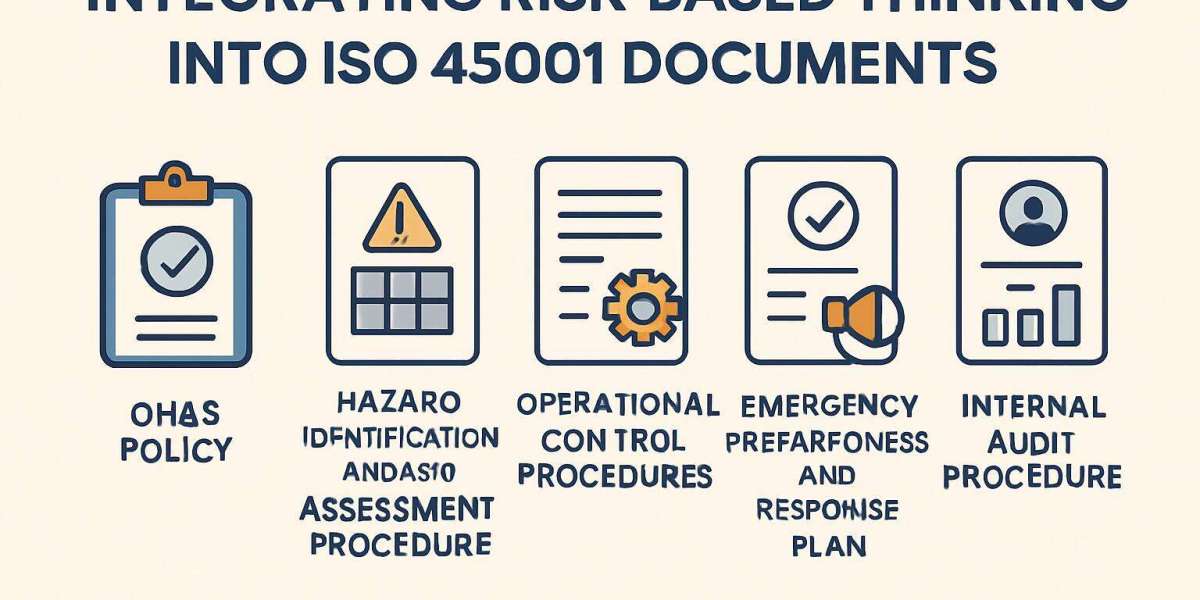In today’s evolving industrial and organizational landscape, health and safety risks are more dynamic than ever. ISO 45001, the international standard for Occupational Health and Safety Management Systems (OHSMS), places a strong emphasis on proactive risk-based thinking. One of the most critical aspects of implementing this standard effectively is integrating this approach into your ISO 45001 documents. This ensures that risk management is not an isolated activity but an inherent part of all safety-related documentation.
What Is Risk-Based Thinking in ISO 45001?
Risk-based thinking refers to the proactive identification, evaluation, and mitigation of risks and opportunities within an occupational health and safety context. Rather than responding to incidents after they occur, ISO 45001 encourages organizations to anticipate potential hazards and put control measures in place to minimize or eliminate them.
This shift from reactive to proactive safety culture should be reflected thoroughly within ISO 45001 documents, as documentation forms the backbone of how policies, procedures, and operations are structured.
Why Integrate Risk-Based Thinking into ISO 45001 Documents?
The ISO 45001 standard doesn’t just require organizations to think about risks—it mandates evidence that risk-based thinking has been implemented. This evidence largely comes in the form of properly structured and maintained ISO 45001 documents. These documents serve to:
- Demonstrate compliance to auditors and stakeholders
- Provide clear guidance to employees on risk management
- Ensure continuity and consistency across operational processes
- Support the continual improvement cycle of the OHSMS
Without integration of risk-based thinking into the documents, organizations may struggle to meet compliance or manage workplace risks effectively.
Key ISO 45001 Documents to Embed Risk-Based Thinking
To integrate risk-based thinking, specific ISO 45001 documents need to be created or updated:
- OH&S Policy
The OH&S policy should explicitly state the organization’s commitment to risk-based thinking. It must outline how the organization identifies, assesses, and addresses occupational health and safety risks.
- Hazard Identification and Risk Assessment Procedure
This document forms the core of risk management in ISO 45001. It should include a defined methodology for identifying hazards, assessing risks, evaluating their significance, and determining the necessary control measures.
- Operational Control Procedures
These procedures should reflect controls based on identified risks. For example, if a particular machine poses a risk of entanglement, operational procedures should clearly define lock-out/tag-out procedures to prevent accidents.
- Emergency Preparedness and Response Plan
Effective emergency response depends on anticipating various risk scenarios. These plans should incorporate likely emergencies identified through risk assessments and include mitigation and response strategies.
- Internal Audit Procedure
The internal audit procedure should include criteria for evaluating whether risk-based thinking is adequately reflected throughout all other ISO 45001 documents.
- Management Review Records
These records must show how top management reviews occupational health and safety risks, evaluates the effectiveness of risk controls, and decides on further actions.
Practical Steps for Integration
Step 1: Perform a Risk Assessment Gap Analysis
Start by reviewing all existing ISO 45001 documents to assess how well they incorporate risk-based thinking. Identify areas that require revision or development.
Step 2: Involve Cross-Functional Teams
Risk assessment and documentation should involve employees from different departments. This helps capture diverse perspectives and improve the accuracy of hazard identification.
Step 3: Use a Standardized Risk Matrix
A uniform risk matrix allows for consistent evaluation of risks across the organization. Include this matrix in relevant ISO 45001 documents for reference.
Step 4: Train Document Owners and Stakeholders
Ensure that personnel responsible for maintaining ISO 45001 documents understand how to apply risk-based thinking principles in their specific areas.
Step 5: Monitor and Update Regularly
Risk environments evolve over time. Establish a system for the periodic review and update of all ISO 45001 documents to reflect new hazards or changing conditions.
Benefits of Integration
Integrating risk-based thinking into your ISO 45001 documents brings tangible benefits:
- Enhanced employee safety and morale
- Reduction in workplace incidents and near misses
- Increased confidence among clients and regulatory bodies
- Streamlined compliance with other ISO standards
Furthermore, when ISO 45001 documents reflect robust risk management practices, they become a valuable tool for organizational learning and continuous improvement.
Conclusion
Risk-based thinking is not just a conceptual framework; it must be deeply embedded in the operational and procedural DNA of an organization. This is achieved through carefully crafted and well-maintained ISO 45001 documents. From policies and procedures to audits and reviews, every document should demonstrate a clear link to risk identification and control. Organizations that succeed in this integration not only fulfil the requirements of ISO 45001 but also build safer, more resilient workplaces.



